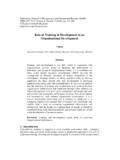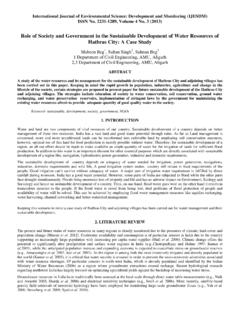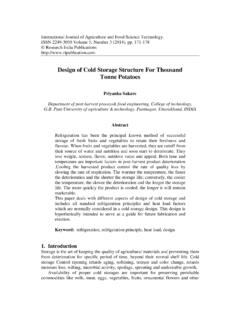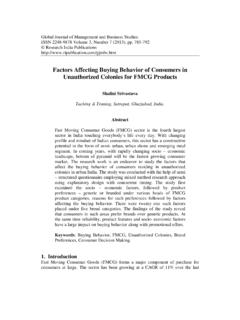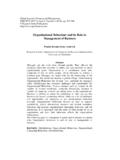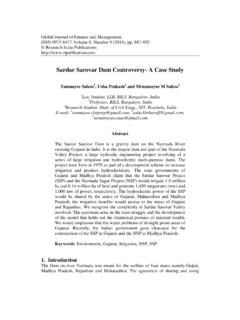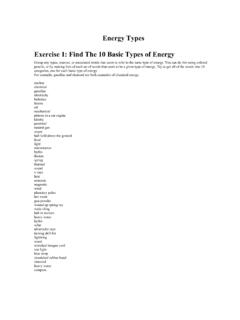Transcription of Passive design strategies for cold and cloudy climate
1 International Journal of Engineering Research and Technology. ISSN 0974-3154 Volume 10, Number 1 (2017). International Research Publication House Passive design strategies for cold and cloudy climate Author Ar. Rutika Ajri Tendulkar Assistant Professor, Department of Interior Designing, CNCVCW, CSIBER, University Road, Kolhapur, Maharashtra, India. Abstract Bio-climatic chart Improving energy efficiency through technological advances A bioclimatic chart is a preliminary analysis tool used during has been the focus for next generation of buildings. However, the early planning stages of a building project to identify the living in cold climates is more energy demanding than in hot most efficient Passive cooling and heating strategies based on climates. The main idea is to cut energy consumption by the climate and location of a building site. Passive strategies . The study focuses on most cost effective means of providing heat to building. The innovative combining Passive solar applications, when included in initial building design , adds little or nothing to the cost of building, yet has the effect of realizing a reduction in operational costs and reduced equipment demand.
2 Keywords: Passive solar heating, rock bed, sun space, strategy, earth berm, building form, human comfort. Introduction In recent years, interest in making use of energy from the sun has accelerated enormously. The problem is how to convert the energy at reasonable cost into a reliable usable form for heating and cooling of buildings. Optimal study takes the Passive form of architecture to create comfortable living spaces. The mechanism of heating and cooling equipment is usually referred to as a system. In Bioclimatic chart for Shimla Passive building designs the system is integrated into the building elements and materials the windows, walls, floors, Throughout the year the temperature is low, so solar Passive and roof are used as the heat collecting, storing, releasing, and heating strategy is needed to bring it in comfort zone. distributing system. Storage of solar energy is a challenge than collecting. Combining strategies together with respect to design strategies for cold and cloudy climate orientation, form, and other design concepts, will lead to a The main criteria while designing are its built form, sustainable approach.
3 For study purpose, the climatic data of orientations, wall area, window area, thermal insulation, and Shimla, Himachal Pradesh, India is considered. thermal mass. Thermal strategies are to maximize warming effects of solar radiation and to reduce impact of winter wind. Climatic data for cold and cloudy Shimla Site scale: solar Radiation Micro climatic phenomena (left) in valleys wind blows uphill during day (Right) at night the flow reverses Fig. 1 Radiation square for Shimla hourly radiation on horizontal surface, (W/m2). 32. International Journal of Engineering Research and Technology. ISSN 0974-3154 Volume 10, Number 1 (2017). International Research Publication House Slope location based on climate Sunspaces can be used to collect the suns heat, store it centrally, and distribute it to other rooms. The wind is preheated in the sunspace before entering the building. A. sunspace, unlike direct gain and trombe wall systems, adds a room to the building.
4 Winter section: Two openings are provided on the wall dividing the sunspace and room. The air in the sunspace rises when heated by radiation, and is drawn inside the room and cool air in the room which is at a lower level is let back in Fig. 4 - solar radiation varies with terrain respect sunspace. This forms a cycle of Passive heating air flow. Aspect is the combined slope and orientation of a surface in Summer section: Low inlets and high outlets can be used in a relation to the sun. A surface perpendicular (normal) to the "stack effect" which can be in the form of wind catchers. suns rays receive most radiation per unit of surface area. Since warn air will rise. A wind catcher placed with an Therefore, south facing slopes receive more sun than other opening exposed to the prevailing wind direction forces the air orientations, easterly slopes receive more morning sun, and inside and warm air inside the room is drawn out due to westerly slopes receive more afternoon sun.
5 Steeper slopes negative pressure formed inside the room. Sunspace can be generally receive more sun than flat areas. ventilated to the outside to avoid heating. A properly vented sunspace can function much like a Building scale: screened-in porch. Operable windows and/or vent openings should be located for effective cross-ventilation and to take Building orientation advantage of the prevailing summer wind. In addition to sunspace, combining effects of earth berm, rock bed can be added for optimum results. Earth berm Earth sheltering is the architectural practice of using earth against building walls for external thermal mass, to reduce heat loss, and to easily maintain a steady indoor air temperature. Earth sheltering reduces heat loss in two ways: - by increasing the resistance to heat flow of the walls, roof, and floor and by reducing the temperature difference between inside and outside. At a depth greater than 2 ft. ( ) below Fig. 4 - Interior space should be arranged so that rooms with high the earth's surface, daily temperature fluctuations are heating and lighting requirements are arrayed along the south wall.
6 Negligible. Long east-west plan arrangements increase winter sun-facing skin available to collect radiation. Generally, building oriented along an east-west axis is more efficient for both winter and summer cooling. This orientation allows for maximum solar glazing (windows) to the south for solar capture for heating. This orientation is also advantageous for summer cooling conditions since it minimizes east-west exposure to morning and afternoon summer sun light. Fig. 6 Schematic section of earth berm Sunspace Earth berming calculations: In a radial path calculation method, the variables consist of the resistivity of the soil, the depth of the wall and the slope of the ground surface. For any given depth X, the effective R is given by: ERx = 2 (X) (Rsoil) (90-m / 360). (Source: ASHRAE). Where, m is the slope of the ground surface in degrees, Rsoil is the unit resistance of the soil and Fig. 5 (left) Schematic section for winters ERx is the Effective Resistance at the depth x.
7 (Right) Schematic section for summers 33. International Journal of Engineering Research and Technology. ISSN 0974-3154 Volume 10, Number 1 (2017). International Research Publication House the Effective R for a depth of 4 M( Feet), Specific heat of rock = Kcal/Kg/deg C. under a horizontal ground surface, is given by substituting X Thermal capacity of rock = 1800 X = and m = 0, so that = 400 Kcal/M /deg C. ER8 = 2 ( ) / (90-0/360) Rsoil = 2 X X 4 Rsoil Temperature range = 20 C. = Rsoil Each M of rock will store = 465 X 20. The geometrical component of the heat flow is independent of = 9300 W/M depth. the soil's thermal properties. For a typical In-situ soil, unit Solution: resistance may be assumed to be about / foot. Temperature difference t = 240 c (20 c) = 22 deg c. Substituting for R soil yields a product of Night heat loss through structure (winter):- A horizontal strip of wall at 8 feet below grade, therefore, can Conduction: [6]. be regarded as having inherent resistance of R26, without the Conduction heat flow rate through a wall of given area can be benefit of any insulating materials.
8 Described by the equation: qc = a x u x t Rock bed A) Conduction through glazing Qc = a x u x t = 175m2 x /deg c x 22deg c qc = w B) Conduction through bermed wall- Qc = a x u x t = 200m2 x /deg c x 22deg c qc = 212 w C) Conduction through exposed concrete Qc = a x u x t = 75m2 x /deg c x 22deg c = 9537 w Total qc= 20,221 w. Fig. 7 Schematic section of rock bed Convection: [6]. Rock beds are a means of enlarging the thermal mass of the Convection heat flow rate between the interior of the building building and thereby increasing the ability to store energy . Air and the open air depends on the rate of ventilation, Air is drawn from the sunspace and through bed of rocks. Heat is exchange. given off to the rocks and air is re-circulated to a location in This may be un intentioned air infiltration or may be the hot space to collect more heat. deliberate ventilation, which can be given in m3 / s. At night when heat is needed, air from the occupied space is The rate of ventilation heat flow rate is described by the drawn through the rock bed, where it picks up heat and equation: distributed back to the occupied space.
9 The rock bed can be Qv = 1300 x v x t located under a concrete slab that will be heated by bed. Where, qv = ventilation heat flow rate, in w Rock bed calculations: 1300 = volumetric specific heat of air, in j / m3 deg c v = ventilation rate in m3 / s Heat loss calculation: [6] t= temp. Difference, in deg c The purpose of this calculation is for the design of a heating If number of air changes per hour (n) is given, the ventilation installation. Heat loss rate for a condition which is the coldest rate can be found as: for 90% of the time is calculated. The heating installation is v = n x room volume / 3600. then designed to produce heat at the same rate. Qv = 1300 x V x T. solar thermal quantity available:- V = 3 X 1987/3600 = M3/S. Average daily radiation on horizontal surface = 5900 Qv = 1300 x V x T = 1300 X X 22. W/M Qv = 47476 W. Average yearly available = 5900 X 365 = 21, 53,400 Radiation through glazing: [6]. W/M The rate of heat flow through glazing is described by the equation: Thermal collection at 40% efficiency of collector =.
10 Qs = A x u x T. 8,61,400 W/M . Where, Thermal capacity of rock:- A = area of window, in M2. Density of rock = 1800 Kg/M . 34. International Journal of Engineering Research and Technology. ISSN 0974-3154 Volume 10, Number 1 (2017). International Research Publication House u = u-value of glass entrance door and the main building. It also reduces the Qs = A x u x T amount of cold or warm air entering the living space when the T= (24-2)/2 = 11 interior door is opened. = 30 x x 11. Qs = 1493 W Conclusion Qs = A x u x T(sunspace). T= (11-2)/2 = 9 The idea of Passive solar heating is simple, but applying it = 300 x x 9 effectively requires attention to the details of strategic design , = 12096W analytic techniques and method of construction. Modest levels of Passive solar heating, also called sun The thermal balance equation is: Qi Qc Qv + Qm = 0. tempering, can reduce building auxiliary heating requirements Qm = 10,28,21,760 W from 5% to 25% at little or no incremental first cost and Mass of rock required :- should be implemented for all small buildings in cold and 10,28,21,760/9300= 11056 M3 cloudy climates.
